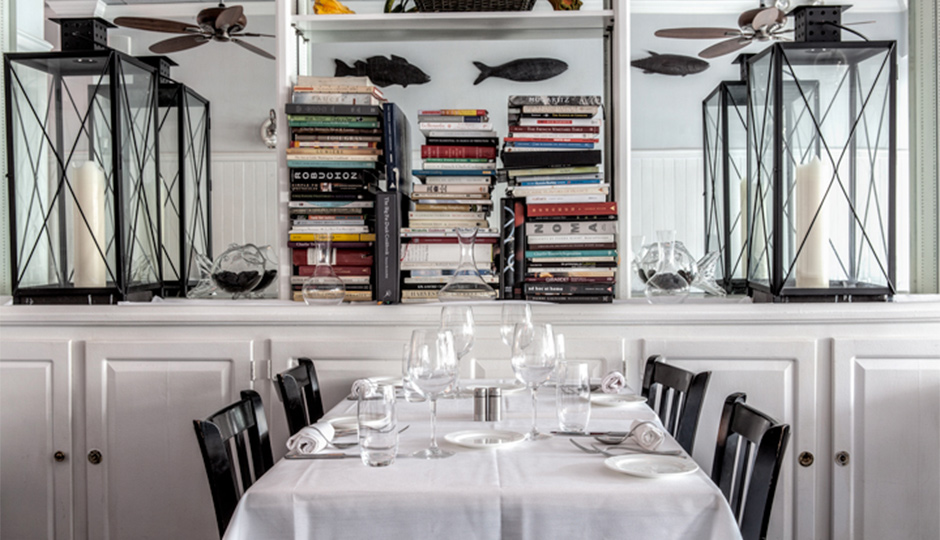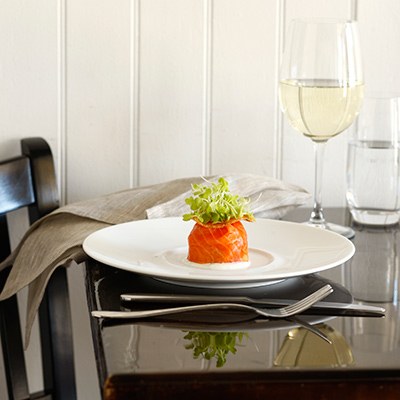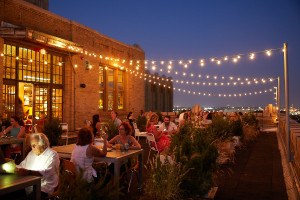A Fish Story: Blackfish Revisited

Blackfish Reviewed | Photo by Samuel Markey
The dining room at Blackfish in Conshohocken is white, but not cold. Not icy, the way some white, restaurant-shaped boxes can be. The dark wood floors help. The matching chairs. The colorful spines of cookbooks stacked on a shelf, making the place look like it’s been styled for an Architectural Digest photo shoot, or maybe something from a summer issue of Martha Stewart Living. Not lively, exactly, but alive.
The white ceilings and white tablecloths and white plates make every color pop. The sharp red of garden tomatoes in a summer salad, the green tangles of seaweed on which sit the stony shells of oysters, the rich, textured yellow-brown of a curry sauce puddling around a fist-sized cut of tilefish perfectly golden from the pan: In this sterility of white-on-white, the plates being put out by Chip Roman’s chef de cuisine, Yianni Arhontoulis, and his crew go off like fireworks. The entire restaurant becomes a blank space, and all you can see are the blooms and sparks in front of you. Everything else fades into the background.
There was a moment when Blackfish was the best restaurant in Philadelphia. It was 2011, and we named it number one on our list of the 50 Best, saying that it was “flat-out fantastic; sophisticated without being overbearingly avant-garde, pretty and fresh without being precious; the perfect restaurant of the moment.” And I have no doubt that it was.
But you have to remember that this was before Laurel, and before Greg Vernick came to town. It was before Kevin Yanaga fired up the grills at Double Knot and before Chris Painter turned his back on Starr’s organization for Wm. Mulherin’s Sons. Before Eli Kulp came to Fork and and Rich Landau opened Vedge. It was five years ago, and five years is an eternity in the culinary life of a city like Philly, where we don’t just burn the candle at both ends, but in the middle, too.
And Blackfish? It was already five years old when it took the top prize. Roman opened in 2006 (following time spent working for both Georges Perrier and Marc Vetri), and while it’d made the list previously, it’d never taken the top spot. 2011 was Blackfish’s year, and it won for doing seafood in a place (Philly and its environs) that has rarely done fish particularly well.
Even today, there’s a lot about Blackfish that’s classic—that speaks to its high point and its fight to hold on to that brilliant moment when it was the best BYO in a city still trying to find its footing as a 21st-century restaurant destination. In the suburbs of that city, actually, which makes it even more remarkable. You can see the Gallic restraint and nouvelle flourishes Roman learned from Perrier in each plate’s careful presentation (every garnish in its place) and in the easy smoothness of his sauces. A spark of Le Bec-Fin’s drama in Blackfish’s tableside pours. Vetri’s controlled rusticity shows in the mains—the big fish plates with their flurry of counterpunching flavors—so that what might otherwise be a mess of quinoa and chunky green squash, black garlic and a blonde brown butter sauce, is tamed by pureeing and searing, boiling and blanching, until it all works as an ideal pedestal for two beautifully browned filets of dorade, crisp as chips at the skin and along the edges, meaty and oily and tender within.
Arhontoulis’s kitchen does a crudo (because of course it does a crudo; because second only to putting fried eggs on top of things, crudos are what Philly chefs love to do), but this crudo is better than most—the parmentier-cut tuna that gorgeously jeweled pink, all mounded up in the well of a white bowl and topped with razor-thin white turnip and carrot rounds. And here, another tableside pour—a jalapeño dashi, warmed just past room temperature, that coats the tuna and splashes the carrots and turnips and brings everything a muted, clean heat and slight sourness that is so ideally calibrated, I can taste the hundreds or thousands or tens of thousands of times this exact broth has been made before. A perfection born of practice.
Not everything works so well. The risotto, spiked with a shot of marsala wine and topped with house–made breadcrumbs and parmesan, was soggy (dripping, actually) and carried a vague aftertaste of onions. The chicken liver pâté had an admirable smoothness and deep, funky flavor that I loved (and the portion was huge), but it was surrounded by a strange garden of accompaniments, of which the tiny, almost translucent pickled beech mushrooms were the best (and most wedded) and the coarse-ground espresso the worst, mostly because it felt so dated—a throwback to the cheapjack modernist flourishes of 10 years ago, when weirdness for weirdness’s sake was looked at as proof of latent genius, not as simply overcrowding the plate with things (like the crushed hazelnuts, too) that were unnecessary.

Smoked Salmon at Blackfish | Photo by Jason Varney
But then there was the tilefish with its curry sauce, thickened by a smear of yellow squash and wonderfully pared with a fan of maitake mushrooms, whose dark, earthy, almost smoky flavor offset the lightness of the fish in the best possible way. There was the smoked salmon, wrapped around a breaded and deep-fried hen’s egg, set in a smear of chive-flecked sour cream and capped with an almost arrogant round of paper-thin potato crisp and a wild tangle of mizuna. Here, the kitchen’s (and Chip Roman’s) talent and history were condensed into a single dish, showcased in a clean, controlled, practiced and thoroughly comprehensive way. The salmon was delicious, but that should be a given. The hen egg, inside its crispy golden-brown jacket, was a perfect (and I mean perfect) poach, with the white stiff and the sunny, rich yellow bleeding out across the plate as soon as it was broken open. The sour cream (sauce, for lack of any other sauce) was a nice play on the flavors and textures of a caviar presentation, and the Kentucky Derby hat—that potato crisp and mizuna fascinator? The geometry of it just worked. Pointless, show-offy and ostentatious, sure, but in the best possible way. It was arrogance earned. And justified, too, when I looked around the room and saw the colors of it—the garish tangle of mizuna, the perfect pink of the salmon—on nearly every table.
So this is what it comes down to. Blackfish remains largely the restaurant it was in 2011: an old-school BYO with delicate, quiet service and a room made for showcasing the food more than the architecture. There are plates rotated on and off the menu that are labeled as Blackfish classics—reincarnations of dishes that once defined the restaurant—and there are plates that change daily (with the season, with the catch available from the seafood suppliers, with the whims of the staff). There are tasting menus that can be remarkable (like a recent lobster-bake-themed night), and all those other things that restaurants do to keep it fresh for crowds that have been coming for most of a decade already—regulars who found the place in its heyday and hold just as tightly to those first, best moments as the kitchen does. It’s a solid restaurant that occasionally flirts with greatness, but it feels stuck in a moment that the rest of us are no longer inhabiting.
Blackfish feels fundamentally like the restaurant it was when we called it the best in Philly.
The problem? Philly is no longer the same place it was in 2011.
Stars: 2 stars – Come if you’re in the neighborhood.
Blackfish [Foobooz]


